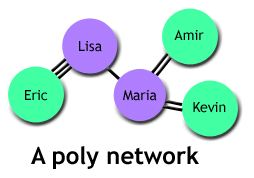
“I'm going on a camping trip this weekend with my . . . people . . . my husband and my boyfriend and my . . . I don't know what she is . . . my friend? . . . my husband's and boyfriend's girlfriend. ‘Metamour' is the word I hear used for that, but you've probably never heard of it.”
There's got to be a better way! So, I've spent some time thinking about language. Only fairly recently has polyamory developed an organized culture, and the language around it is still forming. Because of that, there is not complete agreement on how the words arising to fill the needs of the polyamorous are used. In this entry I’m sharing my understanding of some of the vocabulary but I acknowledge that others out there may dissent.
Some phrases I've heard used as a way of referring to a network of people connected by romantic, loving relationships are poly family or relationship network or poly network. There are some nuances in the way these phrases are used. Poly family usually refers to a group of people who all would agree they have a caring relationship with all the other members – although some might not have a romantic or sexual relationship with every other member.
Example usage: “I'm going on a hike this weekend with my poly family.”
Relationship network or poly network usually refers to a set of people tied by relationships where at least some members do not have close relationships with all of the others. I like all three of these phrases because even a listener uninitiated to polyamory can visualize what they mean to some extent.
Example: “I know Rhiannon because she is a member of my extended relationship network.”
Polycule is another word I’ve read on poly websites or in poly books to refer to a similar concept. The term is based on the word molecule combined with poly for polyamory. The word cleverly evokes an image of the relationships in a poly structure as atoms connected by bonds of different strengths and types. I love this word for its creativity and the vivid imagery of a molecule. It's one of those cute words that isn't practical or useful yet. I hope it catches on, but at the moment using this word in casual conversation raises more questions than it answers.
Example usage: “Franco is a member of my polycule.”
Others simply refer to their relationship by the number of members. If there are three members, it might be a vee or a triad. A vee refers to situation where one person has two partners who are not romantically involved with each other. In a triad, the two partners may or may not be involved with each other. If there are four members, it is called a quad.
Example: “Diana has been part of a triad with Adrian and Karen for three years.”
At times I've used the term quad to refer to the relationship arrangement I am in, and I think that's the term that my husband, Alex, prefers. It's short and easy to say, but people uninitiated to poly are usually a little confused and we often have to explain further.
Our relationship arrangement looks like this:
Note that I've decided to avoid conjecturing whether any of these relationships are single-bonded, double-bonded, or triple-bonded by giving each pair a single bond. I suspect that any other route I took would be controversial with someone. I’d prefer to just describe the relationships. I’ve been married to Alex for 13 years now, and I’ve been dating Julian (and Alex dating Hanne) for two. Julian and Hanne have been together for 3-1/2 years. Alex and Julian had a distant relationship for a while, but have grown closer recently. They’ve never considered themselves to be in a romantic relationship with each other. Hanne and I were the first two to meet each other, through a personals site, though a romantic relationship never really developed between us. We had an extended period when our relationship had a lot of animosity, but over the past nine months we’ve worked hard to repair things and I would consider her a friend now.
I've noticed that my boyfriend, Julian, has been referring to us as his poly family more often lately. There was a time in the past when Hanne and I were not getting along very well and the relationship between Alex and Julian was not very strong either when I would have said that poly family was the wrong term to apply to us. However, we've worked hard at building the diagonal relationships over the past year, and it makes more sense to apply that term now. Personally, I'm a little hesitant to use a phrase like that until we as a group have had some more mileage under our belts where everything has been working well consistently among the four of us. I think for the moment I'll stick with referring to my quad or perhaps to my . . . people . . . you know, my husband, and boyfriend, and . . . their girlfriend.
I thought that having the initial entry in this blog be about the language that we use to refer to poly groups would be a good way to introduce my little poly group. In this blog I hope to discuss some of the fun and wonderful things about polyamory as well as address some of the issues that inevitably arise. I'd like to give you a broad view of how a topic is discussed in the polyamorous community, as well as talking about how that topic has manifested in my own life. In the process, I hope to share stories with you from the relationships I have now and have had in the past and from other polyamorous – and monogamous – people I know. Polyamory can be painful or blissful at different times, but it's always an adventure. Come along for the journey!
Side note: Although the culture of polyamory in modern America is fairly recent, various forms of non-monogamy have a long history in many world cultures. That makes me curious about what terms they used for these roles and relationship structures. The only ones I can think of is the use of sister-wife in fundamentalist Mormon polygamist culture and the use of wife or mistress in Western history to distinguish the roles of the various women a man is romantically or sexually involved with. Surely there are more that I’m just not aware of.


2 Comments
I enjoyed reading about your poly group! Thanks and I can’t wait to read more. Really interesting.
I love your blog! I also live in the Midwest and am poly!